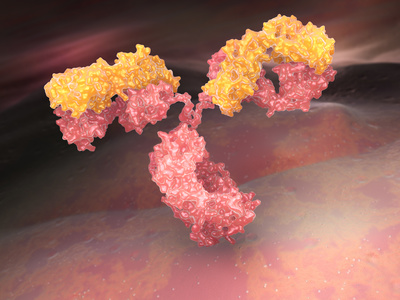Journal Club: RP-UHPLC-MS versus peptide mapping for antibody characterization

Introduction and background
Monoclonal antibodies (mABs) are immunoglobulin molecules that bind to the same epitope and have a variety of applications in medicine and healthcare (e.g. as drugs). Although therapeutic mABs are extremely favorable due to their specificity, they are heterogeneous due to their manufacturing process and hence provide a challenge for characterization.
During expression, purification and storage, enzymatic and chemical modifications such as e.g. oxidation or glycosylation occur. Changes in these modifications can interfere with their safety and efficacy. In case these modifications are classified as critical quality attributes (CQAs), they are been mandated by the regulatory guidelines to be fully characterized. For their evaluation, stress studies can be applied.
Due to a lack of structural resolution, size exclusion and ion exchange chromatography can only be used for routine analysis of fully intact mABs. For a more detailed characterization, peptide mapping can be applied afterwards on fractions collected. Peptide mapping is a method where the mABs are proteolytically digested into peptides, followed by LC(-MS/MS) analysis. Due to some disadvantages of “normal” peptide mapping, an improved high-throughput RP-UHPLC-MS (reversed phase ultra high performance liquid chromatography mass spectrometry) method was developed by Zhang et al.. In this blog article, we will go through this method focusing on stress studies and method qualification.
Method optimization and stress studies
The new method includes limited proteolysis of Immunoglobulin G by the IdeS enzyme, which specifically cleaves the IgG heavy chain below the hinge region between the glycine residues in ELLGGPS. Applying disulphide bond reduction, this results in three different 25 kDa fragments (light chain (LC), VH-CH1 (Fd), and CH2-CH3 (Fc). To avoid any interference of the C-terminal lysine variant with the Fc peak, the mAB was first treated with carboxypeptidase B followed by IdeS digestion. Using two different mABs, the best conditions for the digestion were evaluated. After optimization of the sample preparations, the RP-UHPLC method was developed through optimization of parameters such as gradient, flow rate, column selection, and temperature. To avoid the problem of a reduced peak resolution due to an increased dead volume between the UV and the MS, minimum length tubing was used to connect column outflow to UV and MS. Furthermore, the connection was established directly between the HPLC outlet and the inbuilt divert valve in the MS.
Applying the new method to characterize the CQAs of a glycosylated mAB, quite a lot of variants were identified. The main CQAs observed included clipping sites in the light and heavy chain (thus fragments), non-glycosylated heavy chains (NGHC), the formation of pyroglutamic acid (PyroE, -18 Da↓), methionine residues oxidation in the Fc region (+16 Da↑) and deamidation (typically at asparagine residues, +1 Da↑). Additionally, the new method was used to compare the CQAs after applying stress conditions such as oxidative stress, high and low pH, and thermal stress with the results obtained by traditional tryptic peptide mapping LC-MS. It was shown that the new method was comparable or superior to the classical peptide map method as seen e.g. by UV induced methionine oxidation in both methods, but exclusive detection of basic pH induced LC deamidation in the new method.
Method qualification
The method was further qualified for measuring Fc oxidation. The parameters specificity, trueness, precision, linearity, and limit of quantitation (LOQ) were evaluated.
Repeatability was determined for sample preparation and injection. For the injection repeatability, the sample was injected 6 times from the same vial and for sample preparation repeatability, 6 individually prepared samples were analyzed consecutively. For the evaluation the relative standard deviation (RSD) of the relative peak areas was calculated. Results of RSD = 4.6% (injection repeatability) and of RSD = 2.9% (sample preparation repeatability) were obtained.
Intermediate precision was performed in a matrix approach (n=6) considering three different days, two analysts and two instruments of even different suppliers. While both analysts obtained RSDs of <2.5%, a total RSD of <15% was observed.
Linearity and trueness were determined in one set of experiment where six mixtures containing stressed and unstressed material in different concentrations (ranging from 0% to 100% unstressed material) were used. The applied oxidative stress was induced by treating the antibody with 0.1% tert-Butyl hydroperoxide (tBHP). Taking the relative peak area of the HC Fc oxidation for evaluation, linearity was seen between 2.6 - 25.8% peak area (R2 = 1) while for trueness recovery values of 98 to 100% were found.
Limit of Quantitation was established through upper LOQ (ULOQ) and lower LOQ (LLOQ). The ULOQ was determined from the linearity / trueness study and was found to be 25.8%. As the empirical establishment of the LLOQ was not possible due to limited sample availability, it was calculated based on a signal-to-noise (S/N) approach and determined as being 1.7% assuming it being 10-fold greater than the noise observed in the blank.
Furthermore, specificity was shown by the removal of the observed-terminal lysine interference by carboxypeptidase B treatment as well as by accurate mass measured by UHPLC-MS.
In conclusion, the presented method seems to be a good alternative for the conventional peptide mapping method for the characterization of CQAs in therapeutic mABs. Within a 10 min UHPLC gradient, a clear separation of the variants was seen, which is quite fast. During qualification of this method for the measurement of Fc oxidation, all validation parameters according to the validation guideline ICH Q2(R1) required for quantitative impurity tests were evaluated, showing a broad linearity and good values for repeatability and trueness. A RSD of <15% for intermediate precision might be considered acceptable considering the fact, that 2 different instruments from different suppliers were used. For specificity, a placebo run or runs with different oxidative stress treatments (maybe in different concentrations) would additionally have been nice. In case this would have been a real analytical method validation and not “just” a method qualification, some more documentation would have been required like e.g. showing the graph for linearity and the regression equation, but this was not the focus of the paper.
